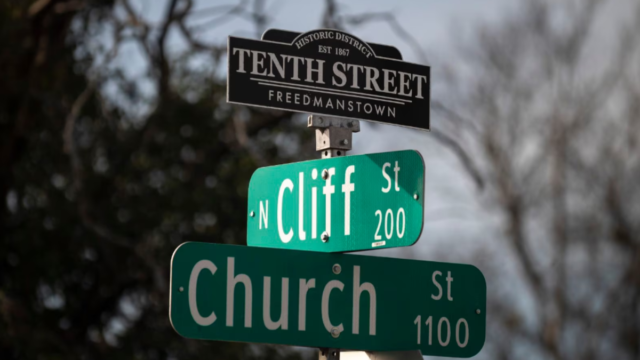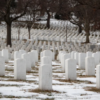
By Sonia A. Rao
Juneteenth marks the anniversary of the day the last slaves in the U.S. were told in Galveston that they were free.
Some of these freed slaves went on to form freedmen’s towns, historic communities founded across the South from 1865 to 1930, according to the Texas State Historical Association. These communities are also called freedom colonies or Black settlements.
In Dallas, some of these communities still exist today. An update on one, Little Egypt, was published this week, so with that in mind, here’s a look at three other living freedmen’s towns, how they started, the struggles they’ve faced and the people still fighting for them:
Elm Thicket-Northpark
Elm Thicket-Northpark, near Love Field, was mostly an African American agricultural community in the early 1900s, research from the Neighborhood Stories project shows. It began to grow in 1917 when the Love Field School of Aeronautics, which turned into a World War II air base and then Love Field, was built.
The only golf course that then allowed African Americans, the Hilliard Golf Course, opened in 1950. However, It was demolished four years later for runway construction.
Church was a big part of the community; there were up to 13 churches in Elm Thicket at one time. Today, there are 10.
Alice Ferguson, a longtime resident, told Neighborhood Stories in 2017 that Elm Thicket was a large, never-ending family. However, there were infrastructural issues and few resources, she said.
Most of Elm Thicket was annexed into the city of Dallas in 1929, but the city delayed connecting the neighborhood to the water and public transit systems.
And as Love Field expanded in the 1950s, people were pushed out of Elm Thicket for housing demolition.
In 1974, 1,700 buildings in Elm Thicket were below Dallas building code standards, in part due to previous Federal Housing Administration redlining policies.
Jonathan Maples, president of the Elm Thicket-Northpark Neighborhood Association, has been a resident for over 50 years.
He said right now, the neighborhood is combating new development and rising home prices.
“We’re dealing with colonization, as I call it, or hostile takeover,” he told The Dallas Morning News this week. “Other people call it gentrification.”
/cloudfront-us-east-1.images.arcpublishing.com/dmn/77EZJW4XV5FO5OTMCCBYEYWJXM.jpg)
In October, Elm Thicket-Northpark won a zoning case that reduces the size limits for new homes built. Maples said this was a victory for the neighborhood.
“That case was important to us, because it shows us that Black and brown people do have a voice, and we should be heard,” he said.
Elm Thicket is celebrating Juneteenth with a freedom day parade 10 a.m. Saturday at the K.B. Polk Recreation Center, and a musical 6 p.m. Sunday at Bethany Missionary Baptist Church.
Joppa
Joppa — also called Joppee, Joppie and Jaffee — was founded in 1870 by former slaves and named after the biblical seaport, according to Morning News archives.
Local historian Donald Payton, who has ancestors from Joppa, told the Morning News in 1993 that Henry Critz Hines,sent to the Miller plantation from Missouri, refused to go back after emancipation. Instead, he settled in the area alongside other formerly enslaved people from Miller and other East Texas plantations.
/cloudfront-us-east-1.images.arcpublishing.com/dmn/6VTS5PVYW5AX7KHVH2ZQEPQR54.png)
New Zion Missionary Baptist Church, one of the most important churches in Joppa, was built in 1882, and served as a schoolhouse, temporary pediatric clinic and voting center. The second-oldest church in the neighborhood is Gethsemane Missionary Baptist Church. Both are still standing.
In 1900, seven families — including the Harrels, Pierces, Wests, Currys, Horns and Allisons — lived in Joppa, according to Morning News archives. Around this time, Joppa was full of shotgun shacks, wooden bungalows and prairie cottages.
More families moved to Joppa in the 1920s to escape racism from old East Texan towns. The area was seen as a safe haven due to its isolated location to the south. However, this isolation also led to neglect.
Joppa’s community goals in 1948 included better bus and mail services, sanitation, annexation to the city of Dallas and water, according to the Neighborhood Stories project. Morning News archives show many homes in Joppa did not have indoor plumbing until the 1980s.
In the 1990s, residents asked the city to build a bridge over the Linfield train tracks so they wouldn’t have to cross them to leave or enter the neighborhood. Without a connection to Dallas, historic homes burned and elderly residents died while emergency vehicles waited at the railroad crossing.
The Freedman’s Town Memorial Bridge that ran over the train tracks was not built until 2007. After another long fight, in 2022, a pedestrian bridge was approved to be built to connect Joppa to Dallas.
Joppa will celebrate Juneteenth at 11 a.m. Saturday at South Central Park with food, music, vendor booths and a screening of 150 Years of Resiliency: A Joppa Documentary.
Tenth Street
Tenth Street, an Oak Cliff community, began to grow and thrive after the Civil War. The first African Americans that lived in Oak Cliff were slaves, and by 1900, the neighborhood had over 500 African-American residents, according to the Texas Historical Commission.
In the 1930s, banks wouldn’t lend money to Tenth Street homeowners or buyers because of redlining policies and homes fell into disrepair as homeowners died without will or deed records. Many younger residents left. And construction of Interstate 35E in 1955 resulted in demolition of almost 200 buildings, pushing more residents out.
However, many historic buildings still stand, including Oak Cliff Cemetery established in 1846 and Greater El Bethel Baptist Church established in 1886. This has helped mark Tenth Street as one of the more well-preserved Black communities of the time in Dallas, and the neighborhood was added to the National Register of Historic Places in 1994.
Preserving Tenth Street’s remaining history has been a struggle for the past few decades. Even with the designation, Oak Cliff’s first certified historic landmark, the Sunshine Elizabeth Chapel C.M.E. Church built in 1890, was torn down in 1999.
And in 2019, the year the district was named one of National Trust’s 11 most endangered places in America, the Tenth Street Residents Association filed a lawsuit against the city of Dallas for “disproportionate demolition” of homes in their historic district compared to “adjacent predominantly White historic districts.”
The lawsuit was thrown out and the Dallas City Council suspended Tenth Street demolitions for one year. In 2021, Tenth Street residents wrote their own neighborhood plan, to preserve existing houses in Tenth Street, increase affordable housing units and protect Black history.
Larry Johnson — a member of the Tenth Street Historic District’s task force, residential association and the Oak Cliff cemetery board — grew up in Oak Cliff a mile from Tenth Street.
He said he is cautiously optimistic for the future of the community.
“Communities of color like Tenth Street have had to work 10 times harder than our white districts to get a tenth of the distance,” he said. “Right now, the discussions are around equity and how to build equity.”
J. Erik Jonsson Central Public Library is hosting an event Saturday at 11:00 a.m. to celebrate and learn more about the history of Tenth Street.









